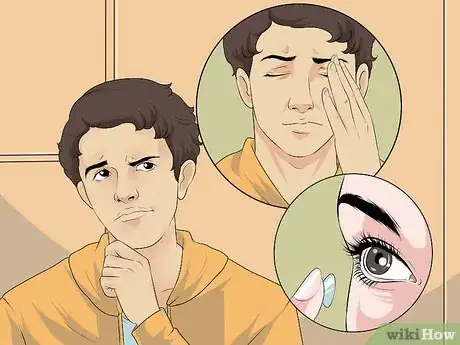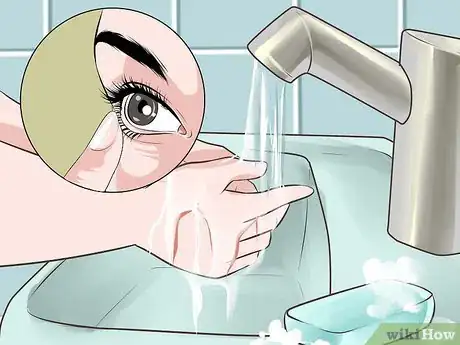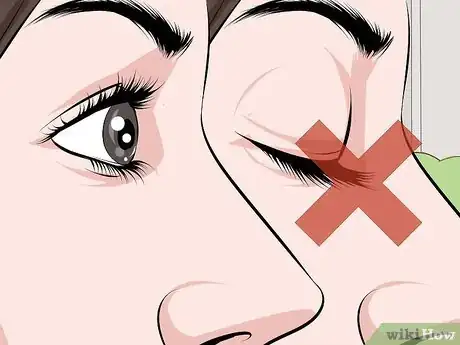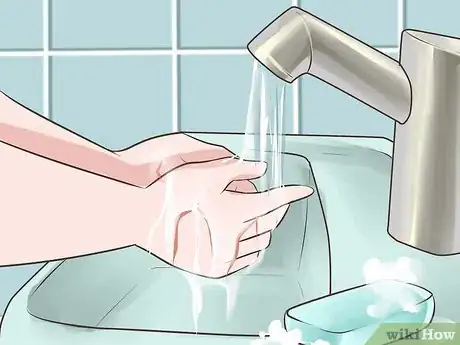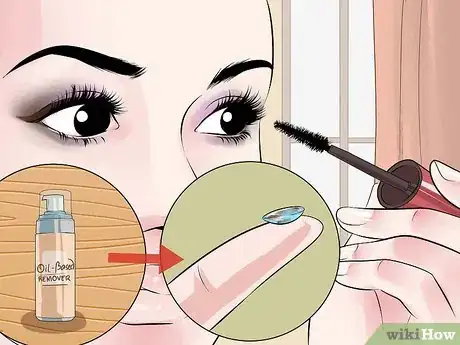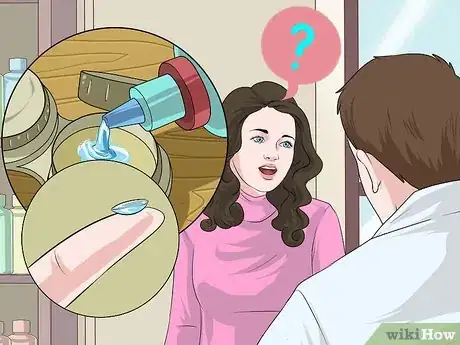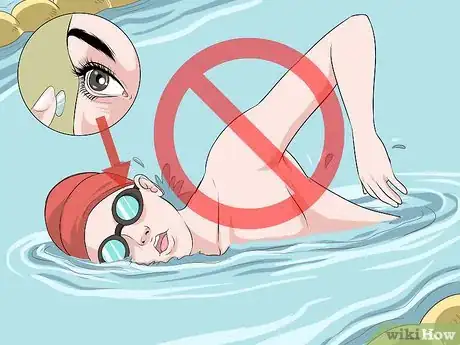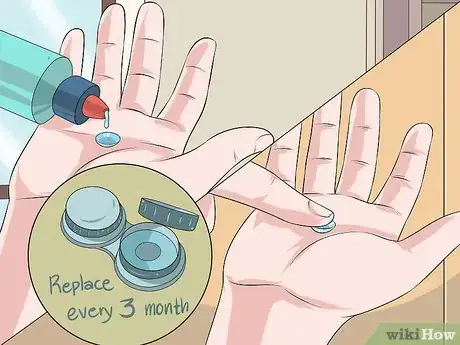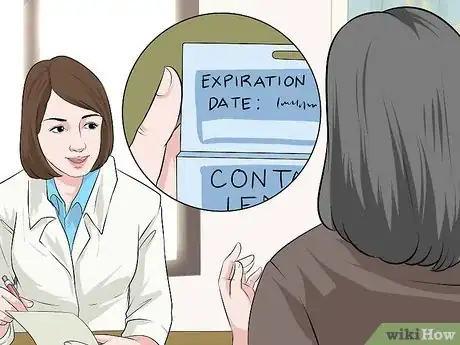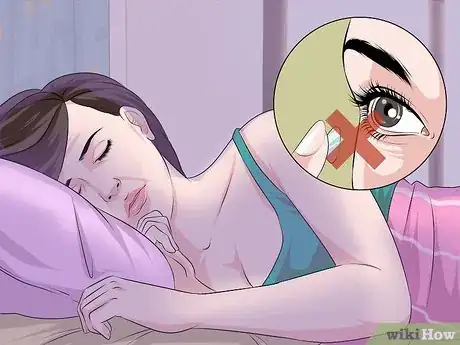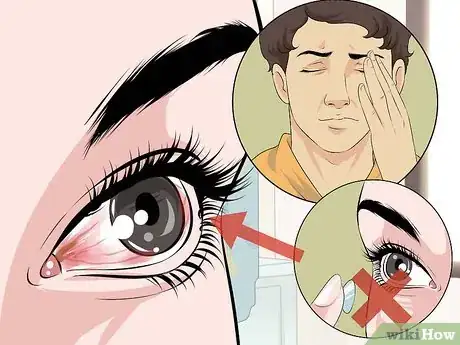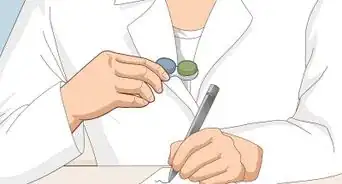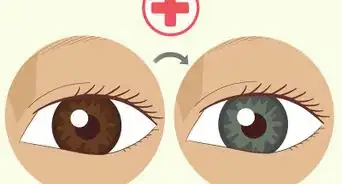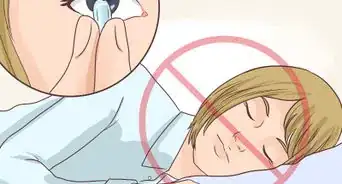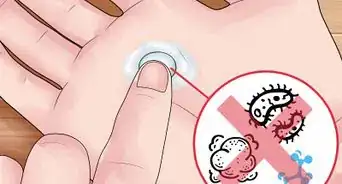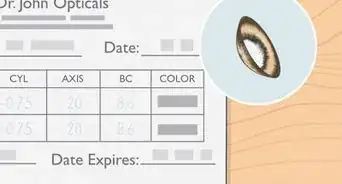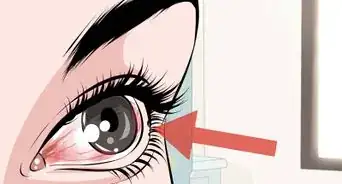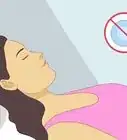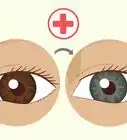This article was medically reviewed by Shaune Wallace, OD. Dr. Wallace is an Optometrist in Nevada with over 14 years of optometry experience. He received his OD from the Southern California College of Optometry in 2006 and is a member of the American Optometric Association.
This article has been viewed 78,855 times.
More than 36 million people in the United States wear contact lenses. This large number attests to the relative overall safety of wearing contacts; nonetheless, many other people refuse to wear contacts based on groundless fears such as the dangers of inserting lenses into the eye, the uncomfortable feeling of having something touching your eye, or the risk of infection. Although these are natural fears, there are several steps you can take to either minimize or eliminate all that factors that lead to these fears. Correct information and knowledge about keeping contact lenses clean and wearing them properly will ease many of the phobias that still exist.
Steps
Overcoming Your Fear
-
1Talk to an optometrist. An optometrist is a specialized professional who is the most qualified person to address your fears and concerns regarding contact lenses. She will be aware of issues such as dry eye, infections, pain or discomfort, and other potential pitfalls. The good news is, she also knows how to calm many of these fears and has solutions to protect your eyes from any serious disease. [1]
- Make a list of fears and concerns to discuss during your visit.
- Ask for a free trial pair of contact lenses for practice.
- Request an eye exam. They are painless, a good idea, and a good practice of what to expect next time you visit the optometrist.
- As an alternative, talk to friends or family members who wear contact lenses and ask them what their fears were and how they overcame them.
-
2Identify your fear. Another important step to overcoming your fear of contact lenses is accessing the reason for the fear and finding out if it is legitimate or not.[2]
- Prior to ever wearing contact lenses, you might fear that something on your eye will cause pain or discomfort. Modern contact lens materials, however, are flexible, comfortable, and designed to properly fit your eyes. If you do experience pain or discomfort, talk to your optometrist about finding a more appropriate lens.
- A popular urban legend cites terrible damage or even death occurring because a contact lens slid up an eye and entered the brain. Biologically, this is impossible because eye anatomy only permits an object on the eye to be removed from the front.
- Eye infection is possible, but modern contact lenses, along with products that disinfect and protect them, makes it almost impossible to get an infection. If this still makes you nervous, then you might opt for daily disposable contacts so that you enjoy a brand new and clean lens every day.
Advertisement -
3Perform a practice run. Try to get used to touching your eyes by practicing for several days prior to purchasing lenses. Not only will you become more confident, but your eyes will also start to desensitize to objects near them. [3]
- Always practice good hygiene by washing your hands thoroughly.
- Take your time. Begin by touching your upper and lower eyelids followed by your eyelashes, then the whites of your eyes. Gently tap your eye a few times to prove to yourself that there is nothing to fear.
-
4Practice not blinking. Our natural reflexes try to prevent objects from entering the eye so a little practice to override this reflex may be in order. The key, of course, is to relax and try not to think about placing an object in your eyes; rather, you are placing a lens on top of your eyes. [4]
- Practice not blinking by placing your index finger on the upper eyelid while your thumb is placed on the lower eyelid to hold open your eye. Take your other hand and imitate putting a lens on your eye so that your mind and eye get used to this motion.
- It is important to practice the same order repeatedly because contacts are designed specifically for an individual eye. This means they are not transferable from one eye to the other.
- The helper hand, the one that holds the eyelids open, needs to be steady in order to prevent blinking midstream.
-
5Look away. It is not unusual to look away when inserting the contact lens. This helps prevent the fear of an object touching your eye. [5]
- Using a mirror to insert contact lenses on your eyes will help take some sensation out of the process. Take your time and practice since looking into the mirror will reverse the image, making it a bit more difficult to skillfully locate where the lens should exactly go.
- Sit close to the mirror and concentrate on the process rather than the actual lens touching the eye. Then, when the lens is near the eye, look up slightly and place the lens on the white part of your eye. Carefully slide the contact into the correct position to finish the process.
- If the lens is not exactly in the right position, that's okay. Try closing your eye and then look up, down, left and right to position the lens in the right place.
Keeping Lenses Clean
-
1Wash and rinse your hands. Many of the fears of wearing contact lenses have to do with hygiene; therefore, it is important to carefully follow directions for keeping your lenses, and anything that comes into contact with them, clean. [6]
- Use mild non-cosmetic soap. Perfumed, oiled, and lotion soaps often cause irritation or even blurred vision because of the residue they leave behind on your hands.
- Make sure your hands are dried with a lint-free towel before handling lenses.
- Keep fingernails short and smooth to avoid scratching or damaging your eyes and/or the lens. If you do have long fingernails, be sure to use the pads of your fingers and not the nails.
-
2Put contacts on prior to applying makeup. There is a correct order for putting on contacts, makeup, and hairspray. Avoid getting these products on your lenses by putting your contacts on first, then makeup and hairspray.[7]
- Same order goes for removal: contacts first, all other beauty products second.
- Avoid creams, lotions, and moisturizers before putting on contact lenses.
- Be careful with waterproof makeup because a lens will bind to the makeup, forcing you to use an oil-based remover and basically destroying the lens.
-
3Use recommended products to clean lenses. Depending on which contact lens you wear, they all require different solutions, drops, and cleaners. Otherwise, you risk damage to both lens and eye. [8]
- Do not reuse solution because bacteria and debris remain in it after the first cleaning. Reusing solution has the potential to cause an eye infection.
- Never use any kind of water to clean your contacts, always use solution.
- Ask your optometrist for a recommended name brand and stay loyal to it. Although generic products are often cheaper, they may not be compatible with your contacts. Generic products are often old recipes sold by contact companies; if you are wearing the latest type of contacts from the company and wearing the previous generation's cleaning solution, you may run into issues.[9] Stick to products made specifically for your contacts.
-
4Avoid using tap water directly on contacts. This applies to using saliva as well. The reason is that lenses will absorb the water and swell, retaining the water with all of its nasty possibilities. This will also distort the lens for fitting and, in turn, scratch your eye making an entryway in for microorganisms. [10]
- For the same reasons as above, do not wear your contacts while swimming. Swimming with contacts in puts you at risk for infection, in particular Acanthamoeba.[11]
- Water is not solution and should never be used as a substitute.
- If no solution is available and your contacts are irritating you, throw them away.
-
5Properly clean and store your contact lenses. It is important to routinely clean, dispose of, and replace your contact lenses. [12]
- Even if you bought “no-rub” solution it is always a good idea to gently rub your lenses between your fingers and then rinse them with solution to remove any unwanted debris from them.
- Cleaning your case nightly. Again, use solution and not water letting the case air dry when you are finished.
- Replace your case every three months.
Wearing Contacts Safely
-
1Keep track of expiration dates for lenses. Only wear your contacts for the recommended amount of time. Remember that prescriptions have expiration dates. If you wear your lenses beyond the expiration date, the surface of the lens breaks down making them vulnerable to the mucus and bacteria that are located in your eyelids. This can lead to infection.[13]
- Ask your optometrist for a chart or scheduler to remind you of when the expiration dates are for your contact lenses. Or, make your own. There may also be an app or online tool available through the company that can remind you with emails or text messages.
- Avoid sharing contact lenses with your friends. Wearing other people’s contacts will increase the possibility of getting an infection, especially if your friend already has any kind of eye condition or irritation.
-
2Take your contacts out at night. Avoid sleeping in your contacts no matter how tired you are. When your eyes are closed, tears are unable to carry an adequate amount of oxygen to your eyes. A lack of lubrication can cause small scratches on your cornea which can cause infection and irritation. [14]
- If this begins to occur frequently, consider getting a prescription for overnight or extended wear lenses for safety.
-
3Remove uncomfortable lenses. Take irritable contacts out immediately to reduce the chances of damaging your eyes. Also, after removing, do not put them back on your eyes until you visit your optometrist. Irritation or scratches on the eye can lead to infection. [15]
- Eyes should always be clear and white. Remove immediately if you have red or itchy eyes, puffing or swelling, blurriness, or pain and discomfort.
- If you do have these symptoms, try to combat it with lubricating drops specifically made for people who wear contact lenses.
Warnings
- If you should ever experience sudden vision loss, persistent blurred vision, light flashes, eye pain, infection, swelling, unusual redness, or irritation, visit your Optometrist immediately.⧼thumbs_response⧽
References
- ↑ http://www.webmd.com/eye-health/visit-eye-doctor
- ↑ http://www.webmd.com/eye-health/tc/contact-lens-care-topic-overview
- ↑ http://coopervision.com/about-contacts/how-put-contacts-your-eyes
- ↑ http://coopervision.com/about-contacts/how-put-contacts-your-eyes
- ↑ http://coopervision.com/about-contacts/how-put-contacts-your-eyes
- ↑ http://www.webmd.com/eye-health/caring-contact-lens
- ↑ http://www.webmd.com/eye-health/caring-contact-lens
- ↑ http://www.webmd.com/eye-health/caring-contact-lens
- ↑ http://www.siliconehydrogels.org/in_the_practice/feb_06.asp
- ↑ http://www.webmd.com/eye-health/caring-contact-lens
- ↑ http://www.allaboutvision.com/contacts/faq/swim-in-cls.htm
- ↑ http://www.webmd.com/eye-health/caring-contact-lens
- ↑ http://www.webmd.com/eye-health/caring-contact-lens
- ↑ http://www.webmd.com/eye-health/caring-contact-lens
- ↑ http://www.webmd.com/eye-health/caring-contact-lens

